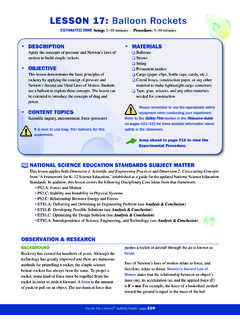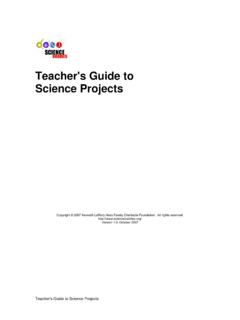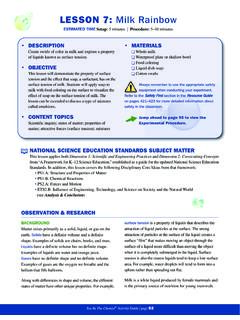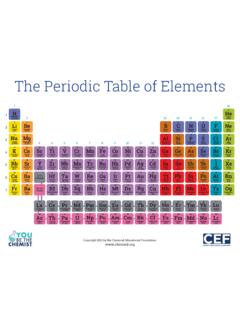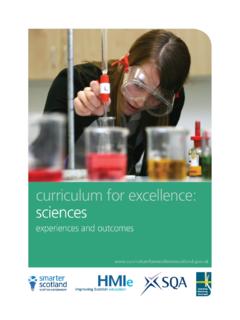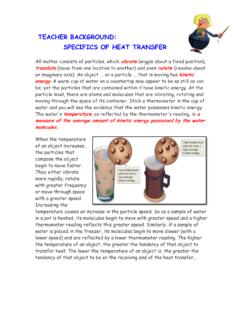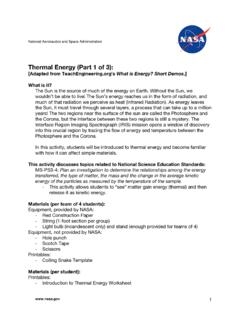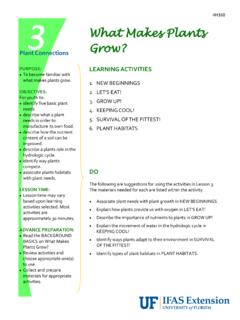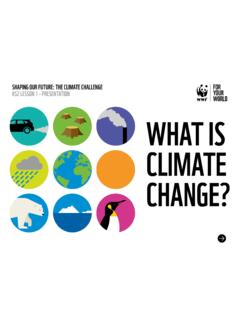Transcription of LESSON 17: Color Clouds - Chemical Educational Foundation
1 LESSON 17: Color Clouds ESTIMATED TIME Setup: 5 minutes | Procedure: 5 10 minutes DESCRIPTION MATERIALS. Demonstrate the relationship between temperature o Clear plastic cups and the process of diffusion by placing drops of food o Hot and cold water coloring in water with different temperatures. o Red food coloring o Blue food coloring OBJECTIVE o Stopwatch (optional). This LESSON demonstrates the relationship between temperature and the rate of diffusion. Students place Always remember to use the appropriate safety drops of food coloring in hot and cold water to equipment when conducting your experiment. observe the effect of temperature on the rate of Refer to the Safety First section in the Resource Guide diffusion. This LESSON can be extended to address on pages 391 393 for more detailed information about other ways to affect the rate of diffusion. safety in the classroom. CONTENT TOPICS Jump ahead to page 222 to view the Scientific inquiry; measurement (temperature); states Experimental Procedure.
2 Of matter ; properties of matter ; energy; diffusion NATIONAL SCIENCE EDUCATION STANDARDS SUBJECT matter . This LESSON applies both Dimension 1: Scientific and Engineering Practices and Dimension 2: Crosscutting Concepts from A Framework for K 12 Science Education, established as a guide for the updated National Science Education Standards. In addition, this LESSON covers the following Disciplinary Core Ideas from that framework: : Structure and Properties of matter : Influence of Engineering, Technology, and Science on Society and the Natural World (see Analysis & Conclusion). OBSERVATION & RESEARCH. BACKGROUND For example, if you push on a balloon filled with gas, matter exists primarily as a solid, liquid, or gas on the you can easily change its shape. Likewise, if you push earth. Solids have a definite volume and a definite shape. on a balloon filled with water, you can change the water Examples of solids are chairs, books, and cups.
3 Liquids balloon's shape as well. have a definite volume but no definite shape. Examples of liquids are water and orange juice. Gases have no Diffusion is the movement of fluid particles from an area definite shape and no definite volume. Examples of of high concentration to an area of low concentration. gases are the oxygen we breathe and the helium that fills different factors can impact the rate at which the balloons. particles diffuse, such as temperature. Temperature is a measure of the average kinetic energy (energy of motion). Along with differences in shape and volume, the of particles in a substance. It is a measure of how fast the different states of matter have other unique properties. particles are moving around. The temperature of a Liquids and gases are considered fluids. A fluid is any substance is measured using a thermometer. substance made up of particles that flow or move freely.
4 A fluid easily changes shape when a force is applied. Energy is defined as the capacity to do work or produce heat . Energy can take many different forms, including Chemist Activity You Be TheLESSON Activity 1: Goofy Guide Guides Putty| page 219 219. LESSON 17: Color Clouds light, sound, electricity, Chemical bonds, mechanical motion, and thermal energy. Thermal energy is the total CONNECT TO THE YOU BE THE. energy of particles in a substance. CHEMIST CHALLENGE. For additional background information, please The transfer of thermal energy from an object at a higher review CEF's Challenge study materials online at temperature to an object at a lower temperature is known as heat . Thus, temperature, thermal energy, and heat are Additional information on states of matter and related, but they are not the same thing. diffusion can be found in the Classification of matter section of CEF's Passport to Science When temperature increases, the kinetic energy of Exploration: The Core of Chemistry.
5 The particles has increased. The increased motion of Additional information on temperature and energy the particles causes them to diffuse faster. Therefore, can be found in the Measurement section of at higher temperatures, the rate at which fluid particles CEF's Passport to Science Exploration: The Core will diffuse is faster than at lower temperatures. In the of Chemistry. experiment, the food coloring will diffuse faster in the hot water than in the cold water. FORMULAS & EQUATIONS. Food coloring is a type of food additive that makes the food HYPOTHESIS. a certain Color (or makes the Color more vibrant). People uDrops of food coloring placed in hot have been adding Color to food for thousands of years to water will diffuse faster than drops of enhance the appeal of the food, either by making it look food coloring placed in cold water because more familiar or vibrant in Color or simply for decoration.
6 Of the faster motion of particles in the fluid. Food colorings were initially developed using spices, crushed seeds, or even crushed insects. However, more recently, chemists have developed synthetic food colorings to create even brighter colors and colors that are hard to find in nature. different colors and food-coloring products contain a variety of Chemical compounds, so there is not one exact formula. Fun Fact Tap water is a mixture of pure water, minerals, and other Without diffusion, it would substances. be almost impossible to The Chemical formula for pure water is H2O. smell anything. You Be The Chemist Activity Guide | page 220. LESSON 17: Color Clouds DIFFERENTIATION IN THE CLASSROOM. LOWER GRADE LEVELS/BEGINNERS Likewise, the distance the particles travel affects the rate Perform the experiment as described on page 222, but of diffusion. Over short distances, such as through a small spend more time on states of matter .
7 Have students identify cup of water, fluid particles will diffuse faster than in a the different states of matter for materials used in the large pool of water. experiment. What are the cups? Solids! What about the food coloring and water? Liquids! In addition, show In addition, temperature is a measure of the average pictures of different things or point out things in the kinetic energy (energy of motion) of particles in a classroom and have the students identify the states of substance. It is a measure of how fast the particles are matter . moving around. The temperature of a substance is measured using a thermometer. Energy is defined as the HIGHER GRADE LEVELS/ADVANCED STUDENTS capacity to do work or produce heat . Energy can take DESCRIPTION many different forms, including light, sound, electricity, Demonstrate the relationship between temperature and Chemical bonds, mechanical motion, and thermal energy.
8 The process of diffusion by placing drops of food coloring in water with different temperatures. Thermal energy is the total energy of particles in a substance. The transfer of thermal energy from an object OBJECTIVE at a higher temperature to an object at a lower temperature This LESSON demonstrates the relationship between is known as heat . Thus, temperature, thermal energy, and temperature and the rate of diffusion and addresses other heat are related, but they are not the same thing. factors that impact diffusion. Students place drops of food coloring in hot and cold water to observe the When temperature increases, the kinetic energy of the different rates of diffusion. particles has increased. The increased motion of the particles causes them to diffuse faster. Therefore, at higher OBSERVATION & RESEARCH temperatures, the rate at which fluid particles will diffuse matter exists primarily as a solid, liquid, or gas on the is faster than at lower temperatures.
9 In the experiment, earth. Liquids and gases are considered fluids. A fluid is the food coloring will diffuse faster in the hot water than any substance made up of particles that flow or move in the cold water. freely. A fluid easily changes shape when a force is applied. For example, if you push on a balloon filled with gas, you can easily change its shape. Likewise, if you push on a balloon filled with water, you can change the CONNECT TO THE YOU BE THE. water balloon's shape as well. CHEMIST CHALLENGE. Diffusion is the movement of fluid particles from an area For additional background information, please of high concentration to an area of low concentration. review CEF's Challenge study materials online at different factors can impact the rate at which the particles diffuse, such as temperature, distance, and the concentration gradient. Additional information on states of matter and diffusion can be found in the Classification of Concentration gradient refers to the difference between matter section of CEF's Passport to Science the concentration of the two fluids.
10 If the concentration Exploration: The Core of Chemistry. gradient is zero, diffusion will not occur. If there is a large difference between the concentration of one fluid Additional information on temperature and and the concentration of the other, then the particles will energy can be found in the Measurement section diffuse faster. In the experiment, the dye particles in the of CEF's Passport to Science Exploration: food coloring are very concentrated. When placed in the The Core of Chemistry. water, they will diffuse through the water where there are no dye particles. You Be The Chemist Activity Guide | page 221. LESSON 17: Color Clouds EXPERIMENTATION. As the students perform the experiment, challenge them NOTES. to identify the independent, dependent, and controlled variables, as well as whether there is a control setup for the experiment. (Hint: If the temperature of the water changes, do the results change?)
